IS13030Two distinct evolutionary lineages of the Astacus leptodactylus species-complex (Decapoda : Astacidae) inferred by phylogenetic analyses
Narrow-clawed crayfish (Astacus leptodactylus Eschscholtz, 1823 species complex) is a widely distributed species, rarely studied, whose taxonomy and systematic are unresolved. The aim of this research was to elucidate the phylogenetic relationship between European and Asian populations, using mitochondrial molecular markers. The results showed that two distinct evolutionary lineages exist. These results are a basis for further studies dealing with taxonomy and phylogeographical history of this native European crayfish.




